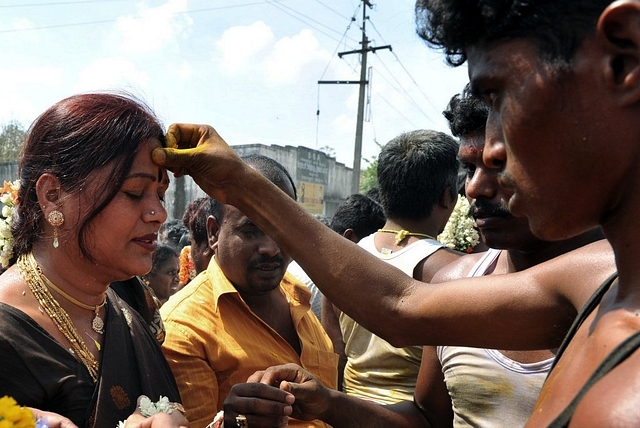
Shani Shingnapur: Let's Be Clear. Hinduism Goes Beyond Gender Equality.
Faux-feminists confuse patriarchal social stagnation with gender-specific ritual spaces. They don’t have to.
The feminist brigade is suddenly up in arms against gender restrictions in Hindu temples. The recent march of feminist activists to the Shani Shingnapur temple in Maharashtra is an example. There are only some isolated temples in India where there are gender based restrictions and exclusivity in visiting. Generally, all temples are open to all genders. But what these faux feminists have failed to see is that such isolated islands of worship with gender-based restrictions exist for all genders.
Gopi Shankar from Madurai is founder-member of Srishti – an organisation that works for justice to gender-variants. He has written perhaps the first Tamil book on gender-variants. It was released by one of Tamil Nadu’s prominent BJP leaders, Smt. Vanathi Srinivasan.
In the book, he points out that Hinduism perhaps is the only religion that has recognized the relationship of gender, body and religion. Thus, he argues that Hinduism has evolved gender-specific worship traditions.
Only in India are there deities for transgenders which can be worshiped ceremoniously only by transgenders and other gender variants. In those areas of spiritual empowerment for specific genders, there are ritual spaces where other genders are not allowed. This is true for all genders in India, male, female and other gender-variants.
Let us take the example of Koovagam transgender festival. In this gender-specific festival, the gender-variants become for one night the brides of the son of Arjuna and they themselves represent the transgender nature of Krishna. Long before US activists and academics ‘discovered’ the rights of gender variants and started marching with rainbow flags and plump funds, India had created gender-specific empowerment spaces for genders beyond the conventional.
Consider the Attukal Pongala festival, which is held for Goddess Bhagavathi in Trivandrum, Kerala. The capital city of Kerala heavily restricts and almost forbids male entry into the place of Pongala.
Rituals and natural spaces where men are forbidden have been there in Hindu traditions from time immemorial. As a living culture, Hinduism continues to evolve gender-specific forms of spiritual empowerment.
Mata Amritanandamayi of Kerala, for example, has popularized and spread the concept of ‘Brahmasthana temples’, where the Divine forms are installed by a woman and the priestess are also women. She has not invented a new form but has adapted and brought in a new context already embedded in Hindu tradition.
In countless Hindu villages, there are women, shamanic women, who empower not just communities but also even temples through their fluid identity between Goddesses and themselves in a very gender specific context.
The faux-feminist movement threatens to destroy this gender-based spirituality which actually empowers and not enslaves the diverse genders. With mechanistic misunderstanding of Hindu diversity these movements confuse, either intentionally or out of sheer ignorance, the current patriarchal social stagnation with gender-specific ritual spaces evolved over the eons by an age-old culture.
Hindu society has valiantly fought against social stagnation and patriarchy using its own cultural symbolism. For increasing the age of marriage for girls Harbilas Sarda and his supporters used Vedic verses. Bhagwan Sri Ramana, that calm saint of non-dualism, not some rhetoric spitting reformer, questioned the basic patriarchal notion that the ultimate liberation could not be obtained in a female body.
Interestingly, the faux feminists – just like patriarchal orthodoxy – believe that the temporal liberation of women cannot happen unless they ape the males and level down all gender-specific diversities that have evolved in the society.
Let us recognize that gender-specific ritual spaces is not discrimination. We need to fight against gender-specific discrimination. We must fight for every gender to celebrate its own physical attributes, sexuality and spirituality. Hindu traditions have well recognized the distinction between the two. Discrimination in Hindu society is the result of a general process of patriarchy – a stage in human socio-cultural evolution, gender specific rituals and ritual spaces are essential to Hindu Dharma. Let us use the latter to shape the socio-cultural evolution.